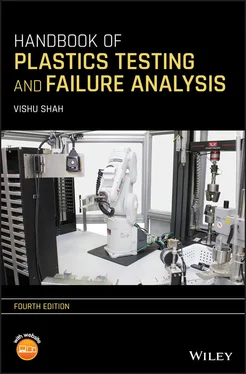bFlow rate: 190/2.16 (T/M).
cMelting point rate 10 °C/min. Tm second melting curve.
dTensile strength shall be determined using a Type I tensile specimen as described in ISO 527. Crosshead speed shall be 50 mm/min ± 10%.
eFlexural modulus shall be determined by specimen 80 ± 2 mm × 10 ± 0.2 mm × 4 ± 0.2 mm as described in ISO 178.
fIzod shall be determined by specimen 80 ± 2 mm × 10 ± 0.2 mm × 4 ± 0.2 mm (Method A).
gDeflection temperature shall be determined by specimen 120 ± 2 mm × 10 ± 0.2 mm × 4 ± 0.2 mm.
hData on 4‐mm test specimens are limited and the minimum values may be changed in a later revision after a statistical database of sufficient size is generated.
1.4.3. Sampling and Conditioning
To reproduce the test results time after time, sampling and conditioning procedures must be religiously followed. The procedures for sampling and conditioning must be clearly specified.
The specifications, without adequate information regarding test methods, are useless. The standard and generally accepted test methods must be specified. If no standard test methods exist, a detailed description and requirements of the test should be an integral part of the specification.
1.5. ADVANCEMENTS IN TESTING TECHNOLOGY
Over the past two decades, plastics testing has changed dramatically. Significant advances in materials and the increasingly demanding nature of plastics applications have combined with global demand for uniformity to produce a requirement for data that goes beyond basic material comparison. Data today are used for design purposes and complex models for the prediction of a material’s end‐use compatibility. As a result, the testing technology that was adequate to provide data in the past has, in some cases, become obsolete and major advances in testing equipment sophistication have been developed to create a whole new environment in the plastics laboratory. One of the main areas for future advancement will be related to the use of plastics‐based composites in the Automobile Industry. Recent amendments to the United States Government Corporate Average Fuel Economy (CAFÉ) regulatory requirements set a national fuel economy standard of 35 mpg by 2020. One of the ways automobile manufacturers will try and meet this goal will be through “light‐weighting”—the replacement of heavy metal parts, both structural and nonstructural, with plastics and plastic‐based composites. Advanced test methods that relate specifically to these new applications will be crucial to the success of the industry to meet the challenge.
The traditional laboratory of the past generated material data using methods that were developed from metals standards and other industries. While adequate for comparing one material to another for basic similarities and differences, the information that was generated did not reflect the variables that are specific to polymers—that is, the effect of temperature on properties and the important role that polymer structure plays on its overall performance in the end‐use application. With the complexity of the applications for polymers increasing, the need for more sophisticated testing techniques has also increased. State‐of‐the‐art polymer testing laboratories today utilize test equipment that is fully instrumented and capable of collecting data with higher accuracy that not only includes the basic properties but also the more complicated effect of external variables on those properties.
A good example of changes in testing sophistication is the universal tester. In the past, this relatively simple apparatus that generates tensile, compressive, and flexural data (among others) was used largely to generate room‐temperature single‐point data, such as tensile strength, in North American units of pounds per square inch (psi) by methods from the ASTM International (ASTM). Today, not only has the sophistication of the equipment advanced but it is being used to generate detailed technical data, such as nonambient stress–strain data for inclusion in computerized multipoint databases such as ISO 11403 Acquisition and Presentation of Comparable Multi‐Point Data. Another use is the measurement of V‐notch shear (losipescu shear) using strain gages that accurately measure strain for precise modulus determination on highly reinforced composites. Most universal testers today utilize computerized data acquisition with Windows‐based software that performs nearly all required engineering calculations and provides multiple options for modulus curve fits and energy calculations. Load cells and extensometers (a strain measurement device) are self‐identifying and calibrating, crosshead speeds are digitally set by computer, and real‐time graphs of stress–strain curves are generated as evaluations occur. Other relatively new accessories that are used with the universal tester are biaxial extensometers for accurate measurement of axial and transverse strain for Poisson’s ratio determinations and bondable strain gauges for the accurate evaluation of stiff composites. In the past, grip separation and other analog measurement methods were the primary methods of measuring strain; today, strain measurement is performed with strain gages and strain gage extensometers along with laser extensometers for more accurate determinations.
It is important to note that as data collection accuracy has increased, so have the requirements for accuracy of test equipment and data collection methods outlined in test methods. For example, ASTM D638 and ISO 527 (International Standards Organization), both tensile property methods, require the use of extensometers to measure strain for modulus determinations. Grip separation and other methods of measuring strain have been determined to be inadequate for the measurement accuracy required at the low strains necessary for elastic modulus calculations.
Another area that has seen a significant advancement in technology is impact testing. Historically, impact testing was limited to Izod impact, which measures the energy remaining in a test specimen under a machine in the notch (essentially a notch sensitivity test), and non‐instrumented drop dart impact tests such as mean failure height, based on qualitative events (pass or fail). While those two methods are useful for comparison purposes, information relative to the impact event itself is very limited. Today, impact equipment such as multiaxial instrumented impact is available, which not only provides data such as force in Newtons required to break a sample, but also complete load–time energy curves, which provide visual data on the impact event itself. Energy values can be chosen for any point on the load/time (or load/deflection) curve. The data along with the curves provide enough information to determine failure modes such as ductile or brittle failure and also initial fracture points.
While the technology associated with single‐point tests, such as those described above, has improved their usefulness for evaluation and comparison of polymers, single‐point tests themselves are being replaced with more sophisticated multipoint tests that are associated with the unique problems related to designing with polymers. As mentioned earlier, most of the early single‐point tests for polymers were based on methods that were taken from the metals industry. These methods assumed that the materials would not change much with changes in temperature, which in the case of metals was accurate. For polymers, temperature plays a significant role in how they will perform when subjected to different environments of stress or exposure to chemicals or both. With polymers being used in more “high‐end” applications, such as automotive applications, multipoint data is becoming more in demand as design engineers are required to simulate mechanical property responses of polymers when exposed to temperature. Mechanical property data generated with equipment such as dynamic mechanical analyzers (DMAs) provide information on the response of mechanical properties (typically dynamic modulus) to temperature and frequency. Other multipoint tests commonly used are outlined in ISO 11403‐1, Plastics‐Acquisition and Presentation of Comparable Multi‐Point Data, and include stress–strain curves at different temperatures, isochronous stress–strain curves developed from tensile creep data, and charpy impact at multiple temperatures.
Читать дальше











